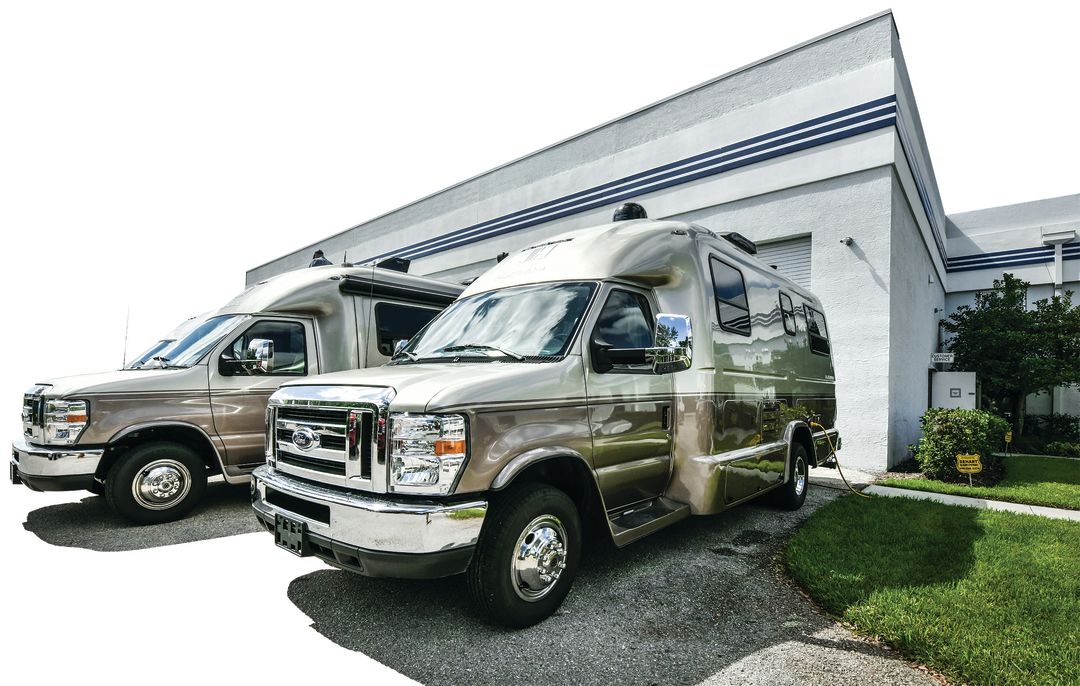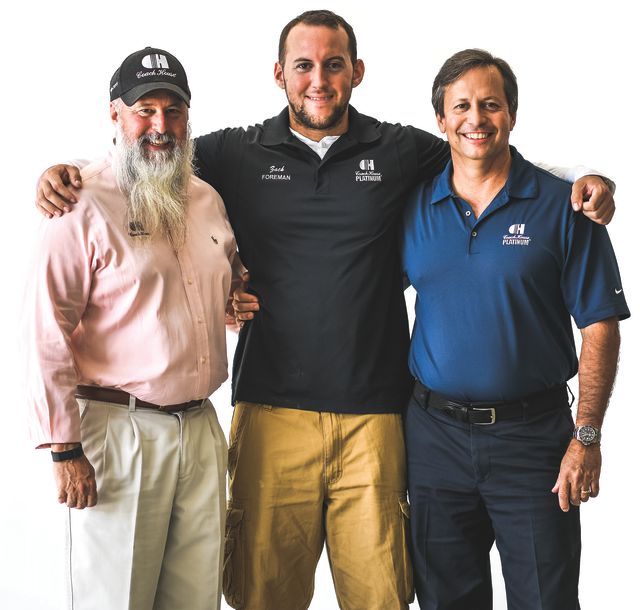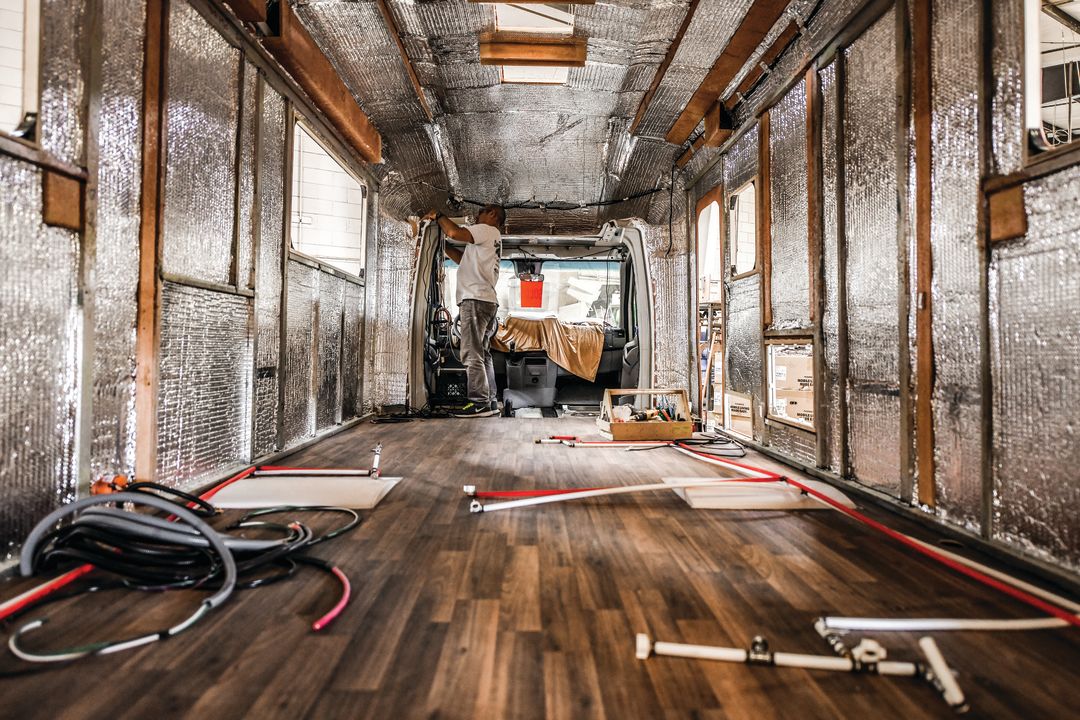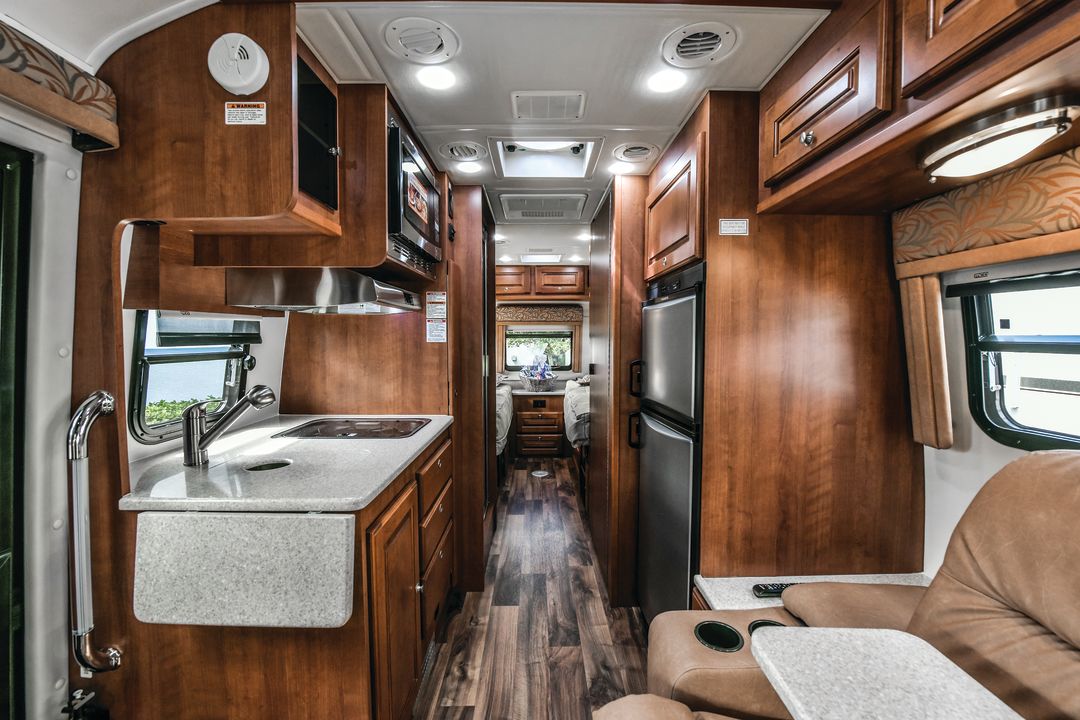Meet the Family Behind Venice's Coach House RVs

Image: Everett Dennison
In 1976, Ruben Gerzeny was doing well as the part-owner of a Volkswagen dealership in Cleveland, Ohio. But his family was choking—literally—on the smoke-filled air of the industrial city. So Gerzeny sold his business, and the family traveled the country for seven weeks in a Volkswagen van towing a pop-up camper, looking for a place with clean air. They chose Venice.
Gerzeny started the Venice-Nokomis Auto World dealership soon after arriving. Van conversions were becoming popular, and by 1985, Gerzeny was converting vans into motorhomes, building pop-top and fixed-top RVs one or two at a time in a 5,000-square-foot warehouse on Warfield Avenue in Venice.

A family affair: David Gerzeny, president; Zach Gerzeny, production manager; and Steve Gerzeny, vice president.
Image: Everett Dennison
Fast forward almost 33 years, and now Gerzeny’s business is Coach House, a nationally recognized manufacturer of Class B and C motorhomes. (They do not manufacture Class A motorhomes, the largest RVs on the road.) Gerzeny’s sons David, 54, and Steve, 51, joined him early on and are now the president and vice president, respectively. Brother Mike, 47, runs Gerzeny’s RV World at four locations in Florida. (Ironically, Gerzeny’s RV World doesn’t sell Coach House motorhomes because the company produces such a limited supply that almost all are sold directly from the factory.)
Coach House employs 64 people today and manufactures 100 motorhomes a year that sell for between $129,900 for Class B and $189,900 for Class C models, a higher price point than the average industry range of $91,000 and $112,000.
Gary Bunzer, who writes The RV Doctor blog, raves that the 2016 Coach House 24-foot Platinum II model was the quietest motorhome he had ever driven. “There was no noise, creaks or rattles, whether it was on the streets, the freeway, gravel or grass field,” wrote Bunzer. He also liked the interior design features of the small luxury motorhome. The galley kitchen, he wrote, is as fully equipped as one in a standard, full-sized motorhome. Push-button, locking drawers were a nice touch, he added, as was a 6-cubic-foot refrigerator, a size seldom found in smaller RVs.
Now is a good time to be making motorhomes. The RV industry had a record-breaking year in 2016 and anticipates a banner year in 2017 and 2018 as well. The growth, which is occurring among all age groups, says Kevin Broom of the Recreational Vehicle Industry Association, is a function of a recovering economy and Americans’ “long-held, deep-seated desire for the road trip.” The use of motorhomes also has expanded. Today’s buyers like smaller, lighter-weight models for tailgating, soccer tournaments and weekend getaways, not just cross-country trips.
Coach House is aiming to get a larger share of this market and recently expanded its 40,000-square-foot plant off I-75 near Laurel Road by 13,000 square feet. The company plans to increase production 25 percent to 30 percent, including adding a new model in 2018. But even with the expansion, Coach House remains a little guy in a $50 billion industry. Nearly 50,000 motorhomes were manufactured last year in the United States, most made by large companies such as Winnebago, which built 13,500 motorhomes.
Coach House’s limited supply and stellar reviews have made its RVs a coveted brand. Steve notes, “I have not been able to use one for the past year. We’re just sold out, we don’t have any.” The plant is at capacity, and it takes about five months to complete most models.
Steve says it was Coach House’s one-piece carbon-fiber reinforced fiberglass design—patented in 2000—that set his company’s vehicles apart from lower-priced competitors, which use up to 15 parts in an RV body.
“We were in here seven days a week for 17 months to produce the gigantic mold so the body would come out as one,” he says.

Image: Everett Dennison

An unfinished interior of a motorhome, above; below, a finished motorhome with upscale appointments.
Image: Everett Dennison
The benefits were immediate. Coach’s one-piece system produced a quieter ride and reduced leaks, which can be a big problem in RVs. Water intrusion leads to interior damage and rotting plywood, which can compromise the electrical system and cause laminate to peel off walls and cabinets.
The molds are expensive. Each one is specific to the make and model of the van chassis that the RV conversion is mounted on. “If we design a mold to fit on a Ford chassis, it only fits on a current Ford chassis,” says Steve. “If Ford decides to modify the cab, we have to modify our molds.” Besides the one-piece fiberglass design, Coach House found more inspiration in the marine industry than in the highly competitive, price-based RV industry.
“We visit a lot of the marine shows and conventions and pick up a lot of cool ideas,” Steve says. “Marine industry interiors far exceed what the RV industry does.”
Coach House’s use of upgraded interior building materials such as high-grade, low-emission plywood and Corian are selling points, as are its heavy-duty hydraulic-powered leveling systems and slideouts that expand the living space.
Customers buy direct from the factory, choosing from several floor plans for the motorhome’s interior. Coach House reps also go to Florida RV shows and one in Hershey, Pennsylvania, to market their models. They’ve also worked to keep employee turnover low, with the average length of service at the factory 14 years.
On one recent day, three workers clad in protective gear were hand-rolling fiberglass coating in an upside-down mold. Freshly painted RVs were drying in an adjacent, dust-free bay. In another part of the factory, workers custom fabricated cabinets and countertops and sewed upholstery.
Workers are paid by the hour and receive quarterly bonuses based on 10 percent of the company’s net profits. And because the cost of warranty repairs comes out of net income, workers are motivated to focus on quality construction.
Once a month, the Gerzenys provide lunch for all the employees. They’ve also closed the plant down to take everyone to a Tampa Bay Rays spring training game.
And after four decades, Coach Homes is staying in the family. Ruben, 82, still checks in regularly at the factory. Steve and David help out on the floor when needed. David’s son Zach serves as production manager. Steve has a son in college who intends to join Coach House when he graduates.
It’s tough to keep a business growing through the third generation, but the Gerzenys have survived the RV industry’s cycles. Steve says his father mentored his sons equally.
“He’s kept us together,” Steve says of his father. “He taught us a long time ago not to keep score. My mom [Beverly] is the glue. We’re all in this together.”



